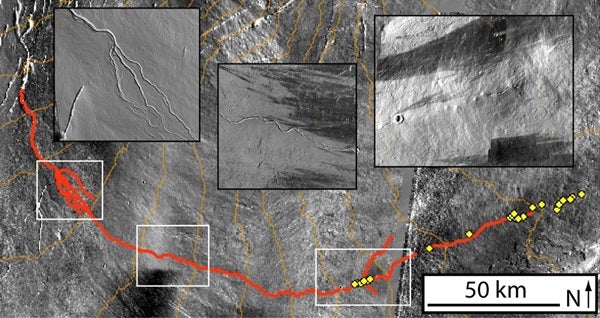Flowing lava can carve or build paths very much like the riverbeds and canyons etched by water, and this probably explains at least one of the meandering channels on the surface of Mars. Whether channels on Mars were formed by water or by lava has been debated for years, and the outcome is thought to influence the likelihood of finding life there.
“To understand if life, as we know it, ever existed on Mars, we need to understand where water is or was,” said Jacob Bleacher, from NASA’s Goddard Space Flight Center, Greenbelt, Maryland. Geologists think the water currently on the surface of Mars is either held in the soil or takes the form of ice at the planet’s north and south poles. But some researchers contend that water flowed or pooled on the surface sometime in the past; water in this form is thought to increase the chance of some form of past or present life.
One of the lines of support for the idea that water once flowed on Mars comes from images that reveal details resembling the erosion of soil by water: terracing of channel walls, formation of small islands in a channel, hanging channels that dead-end, and braided channels that branch off and then reconnect to the main branch. “These are thought to be clear evidence of water-based erosion on Mars,” Bleacher said. Lava is generally not thought to be able to create such finely crafted features.
Bleacher and his colleagues carried out a careful study of a single channel on the southwest flank of Mars’ Ascraeus Mons, one of the three Tharsis Montes volcanoes. The researchers relied on detailed images from three cameras: the Thermal Emission Imaging System (THEMIS), the Context Imager (CTX), and the High/Super Resolution Stereo Color (HRSC) imager, as well as earlier data from the Mars Orbiter Laser Altimeter (MOLA). From these images, the team pieced together more than 168 miles (270 kilometers) of the channel.
At the source of the channel, the visual clues seem to point to water. But at the channel’s other end, an area not clearly seen before, Bleacher and colleagues, including Andy de Wet of Franklin & Marshall College, Lancaster, Pennsylvania, found a ridge that appears to have lava flows coming out of it. In some areas, “the channel is actually roofed over, as if it were a lava tube, and lined up along this we see several rootless vents,” or openings where lava is forced out of the tube and creates small structures, he explained. These types of features don’t form in water-carved channels, he said.
Bleacher argues that having one end of the channel formed by water and the other end by lava is an “exotic” combination. More likely, he says, the entire channel was formed by lava.
Evidence that lava can produce finely detailed features came from a survey by Bleacher, along with W. Brent Garry and Jim Zimbelman of the Smithsonian Institution in Washington, of the 32-mile (51-kilometer) lava flow from the 1859 eruption of Mauna Loa on Hawaii. Their main focus was an island about a mile long in the middle of the channel.
“We found terraced walls on the insides of these channels, channels that go out and just disappear, channels that cut back into the main one, and vertical walls 29 feet (9 meters) high,” Bleacher said. “So, right here, in something that we know was formed only by flowing lava, we found most of the features that were considered to be diagnostic of water-carved channels on Mars.”
Further evidence came from the examination of a detailed image of the Mare Imbrium, a dark patch on the moon that is actually a large crater filled with ancient lava rock. Here, too, the researchers found channels with terraced walls and branching secondary channels.
Bleacher says the team’s conclusions do not rule out the possibility of flowing water on Mars, nor of the existence of other channels carved by water. Even so, he adds, the findings have implications for the geological evolution of this volcanic region of Mars and could ultimately change our ideas about water’s role in the geological evolution of Mars.










